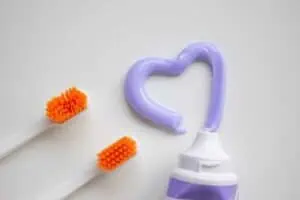Archives

Fact: Purple Toothpaste Contains Active Whitening Ingredients
One fact about purple toothpaste is that many brands often contain active ingredients known for their teeth-whitening properties. Three common ingredients found in these toothpaste formulations are hydrogen peroxide, baking soda, and activated charcoal.
Hydrogen Peroxide – This bleaching agent is found in many teeth whitening products, including those used by your dentist in Sparks. It works by breaking down stains on the enamel and can contribute to a whiter appearance.
Baking Soda – Baking soda has mild abrasive properties that can help remove surface stains from teeth. Its use in purple toothpaste is grounded in scientific evidence as it’s known to be effective as a stain remover.
Activated Charcoal – Activated charcoal can help remove some types of surface stains on teeth (extrinsic stains). However, stains that originate within teeth (intrinsic stains) probably won’t be affected by charcoal.
Myth: Purple Toothpaste Can Dramatically Whiten Teeth
While purple toothpaste may contain teeth-whitening ingredients, it’s essential to manage your expectations. The myth surrounding purple toothpaste lies in the belief that it can dramatically whiten teeth, rivaling professional treatments or over-the-counter whitening strips. In reality, the concentration of active ingredients in purple toothpaste is usually lower than that found in specialized teeth-whitening products, which limits their whitening potential.
Fact: Purple Toothpaste Can Help Maintain Whiteness
Another factual aspect of using purple toothpaste is its ability to help maintain tooth whiteness achieved through professional treatments or stronger over-the-counter products. Regular use of purple toothpaste may assist in preventing new stains from forming and contribute to maintaining a brighter smile.
Myth: Purple Toothpaste Is a Miracle Solution
Don’t fall for the myth or the dramatic videos on social media that show purple toothpaste is a miracle solution. Achieving a truly dazzling smile often requires a multifaceted approach that includes proper oral hygiene, regular dental check-ups, and, in some cases, professional teeth-whitening treatments. Relying solely on purple toothpaste to transform stained or discolored teeth is unrealistic.
Fact: Good Oral Hygiene Is Key
Regardless of the toothpaste color, the foundation for a white smile starts with excellent oral hygiene practices. Brushing your teeth twice a day, flossing daily, and avoiding stain-inducing foods and beverages are essential steps in maintaining a bright smile. Purple toothpaste can be a part of this routine if approved by your dentist in Sparks, but it shouldn’t replace the basics of good oral care.
Myth: Purple Toothpaste Is Suitable for Everyone
Another myth to dispel is that purple toothpaste is suitable for everyone. Some individuals may have underlying dental issues or sensitivity that could be exacerbated by certain toothpaste formulations, including purple ones. It’s essential to consult with your dentist before making any significant changes to your dental care routine, especially if you have concerns about tooth sensitivity or enamel erosion.
Even though purple toothpaste can certainly add an element of fun to your dental routine, it’s crucial to separate the facts from the myths when considering its effectiveness. While purple toothpaste can help maintain whiteness and remove surface stains, it’s not a miracle solution for achieving Hollywood-worthy teeth. Good oral hygiene practices and professional dental care remain fundamental to achieving and maintaining a dazzling smile.
It is that time again when kids eagerly collect bags full of candies during their door-to-door trick-or-treat adventures, and adults are bombarded with sugary sweets in the grocery aisles or haunted by all the treat-or-treat leftovers in the kitchen cabinet. It can only mean one thing – Halloween is here. While we fully appreciate the joy and significance of this tradition, it’s equally important to understand which candies pose the greatest threat to dental health. As your trusted dentist in Sparks, we’re here to shed some light on the worst offenders when it comes to cavity-causing candies.
Candy Corn
Whether you’re a fan or not, candy corn is always present during the autumn season. Despite its seemingly healthy name, this treat can spell trouble for teeth. Its sticky nature means it clings to teeth long after consumption, and its high sugar content provides a feast for those pesky sugar-loving bacteria that can wreak havoc on your teeth.
Taffy
This delightful confection comes in a plethora of mouthwatering flavors and vibrant colors, but don’t be fooled by its charm. Taffy not only contains a substantial sugar content but is also one of the stickiest treats around. This dual threat makes it detrimental to dental health as it can linger on teeth, and its stickiness can even harm dental restorations like fillings.
Lollipops
Lollipops and similar candies like jawbreakers or hard candies that require prolonged sucking sessions expose teeth to sugar for an extended period, which is a recipe for trouble. The longer the candy takes to consume, the more time sugar has to cling to teeth and induce damage.
Sour Candy
Sour candy not only delivers a hefty sugar dose but also adds an acidic punch to the mix. Acid can weaken tooth enamel, rendering teeth vulnerable to sugar-related damage. Excessive consumption of sour candies might necessitate a visit to your dentist in Sparks.
Popcorn
While popcorn may not be sweet, it’s a common find in trick-or-treat bags and an easy nightly snack. Popcorn’s sugar content is relatively low, but it conceals a hidden danger – those sneaky unpopped kernels. Biting down on them unexpectedly can result in tooth damage, leading to broken teeth or the harm of existing dental fillings.
You might not be able to entirely eliminate the temptation for these treats during Halloween, and that’s perfectly fine. What matters most is that you enjoy these indulgences in moderation and follow a daily dental hygiene routine that includes brushing and flossing. Additionally, make sure to see your dentist in Sparks at least every six months for checkups.
